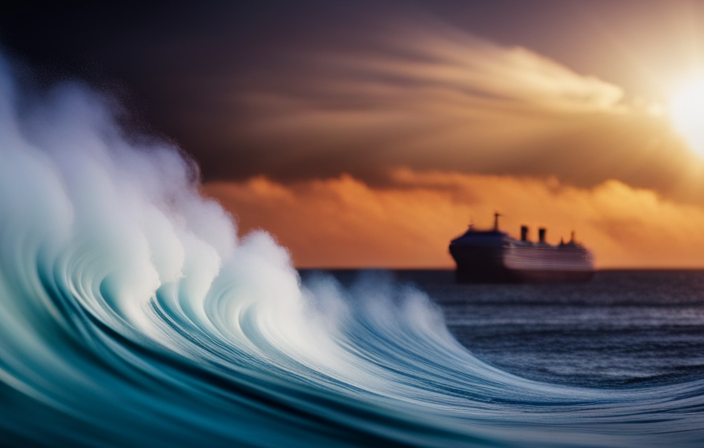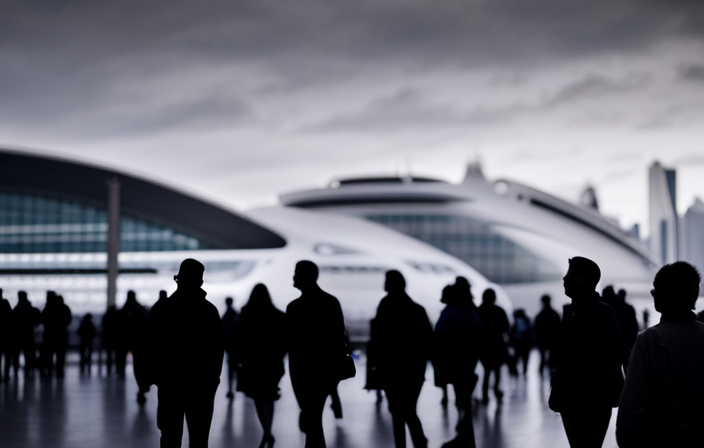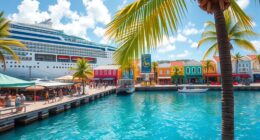Did you know that the fuel consumed by just one cruise ship in a single day can be equivalent to what an entire small town uses?
It’s a staggering statistic that highlights the immense fuel consumption of these floating cities.
As someone who has always been fascinated by the cruise industry, I’ve often wondered just how much fuel these massive vessels actually use.
In this article, we will delve into the world of cruise ship fuel consumption, exploring the factors that affect it, the environmental impact it has, and the various types of fuel used.
We will also examine the regulatory measures in place to mitigate fuel consumption and the economic implications that arise from it.
Finally, we will look towards the future and discuss the potential trends in cruise ship fuel consumption.
Join me as we navigate the intricate balance between luxury and sustainability in the cruise industry.
Key Takeaways
- Ship size, power requirements, speed, and itinerary all contribute to the fuel consumption of cruise ships.
- Fuel consumption has significant environmental impacts, including air pollution, greenhouse gas emissions, and the risk of oil spills and improper waste disposal.
- Fuel costs are a major expense for cruise ship operators, and measures to improve fuel efficiency can help reduce operating costs.
- Alternative fuels and technologies, such as liquefied natural gas and renewable energy sources, are being explored to reduce fuel consumption and minimize environmental impact.
The Basics of Cruise Ship Fuel Consumption
You might be interested to know that cruise ships consume a significant amount of fuel due to their size and power requirements. The fuel consumption of a cruise ship is influenced by several factors affecting costs and the impact on marine ecosystems.
Firstly, the size of the ship plays a crucial role in determining the amount of fuel it consumes. Larger ships require more fuel to propel their massive frames through the water.
Secondly, the power requirements of a cruise ship, including the need for electricity, air conditioning, and propulsion systems, also contribute to its fuel consumption.
Lastly, the cruising speed and itinerary of the ship can affect the fuel consumption as well. These factors influence the environmental impact of cruise ships and will be discussed in more detail in the subsequent section about factors affecting fuel consumption.
Factors Affecting Fuel Consumption
When considering factors that affect fuel consumption in cruise ships, three key points come to mind.
Firstly, ship size and capacity play a significant role, as larger ships typically require more fuel to operate.
Secondly, the speed and itinerary of the ship also impact fuel consumption, with higher speeds and longer distances requiring more fuel.
Lastly, fuel efficiency measures implemented by the cruise line can help mitigate fuel consumption, such as using advanced propulsion systems or optimizing routes.
These factors, when carefully considered and managed, can greatly influence the fuel consumption of a cruise ship.
Ship Size and Capacity
With its massive size and impressive capacity, a cruise ship like this one can consume a significant amount of fuel. Ship design plays a crucial role in determining fuel consumption, as it affects the ship’s weight, drag, and overall efficiency. Fuel consumption analysis is conducted during the ship’s design phase to optimize these factors and reduce fuel consumption. One key aspect of ship design that impacts fuel consumption is the hull shape, with sleeker designs reducing drag and improving fuel efficiency. Additionally, the ship’s capacity also influences fuel consumption, as larger ships require more fuel to power their engines and operate onboard facilities. Maximizing fuel efficiency through careful ship design is essential for reducing environmental impact and operating costs. Transitioning into the subsequent section about ‘speed and itinerary’, the ship’s design is not the only factor affecting fuel consumption; other variables, such as speed and itinerary, also play significant roles.
Speed and Itinerary
To make the most of your cruise experience, it’s important to consider the speed and itinerary of the voyage, which can greatly impact your overall enjoyment and exploration opportunities.
The speed performance of a cruise ship determines how quickly it can reach its destinations and how much time passengers will have to explore each port of call. It also affects the ship’s fuel consumption, as higher speeds require more fuel. Additionally, some cruise lines are exploring the use of alternative fuels, such as liquefied natural gas (LNG), to reduce their environmental impact. These alternative fuels can improve the speed performance of the ship while also reducing emissions.
Considering the speed and choice of fuel can help cruise lines optimize their itineraries and provide a more sustainable cruise experience.
In the next section, we will explore fuel efficiency measures that can further reduce a cruise ship’s fuel consumption.
Fuel Efficiency Measures
You can maximize your cruise experience by learning about fuel efficiency measures that can help reduce emissions and optimize the ship’s performance. Cruise ship operators are continuously implementing fuel efficiency strategies and technological advancements to ensure the responsible use of fuel. These measures include the use of advanced propulsion systems, such as diesel-electric engines, which allow for better control of power distribution and reduce fuel consumption. Additionally, optimizing routes and speeds based on weather conditions and fuel consumption data helps to minimize fuel usage. Onboard energy management systems allow for more efficient use of electricity and reduce the need for auxiliary power generators. By implementing these fuel efficiency measures, cruise ships can reduce their environmental impact and enhance the overall sustainability of the industry.
Transitioning into the subsequent section about the environmental impact of cruise ship fuel consumption, it is important to understand the measures taken to mitigate the negative effects on the environment.
Environmental Impact of Cruise Ship Fuel Consumption
When considering the environmental impact of cruise ship fuel consumption, several key points come to mind.
Firstly, air pollution is a major concern, as cruise ships emit large amounts of sulfur dioxide and nitrogen oxide, which contribute to smog and respiratory issues.
Secondly, greenhouse gas emissions from these ships, particularly carbon dioxide, contribute to climate change and ocean acidification.
Lastly, the risk of oil spills and water pollution is ever-present, as accidents or improper disposal of waste can contaminate marine ecosystems and harm marine life.
Air Pollution
Although it may not be immediately obvious, cruise ships contribute significantly to air pollution due to their high fuel consumption. This has a direct impact on air quality and poses potential health risks to both passengers and crew members.
The combustion of fossil fuels on cruise ships releases various pollutants into the air, including sulfur oxides (SOx), nitrogen oxides (NOx), and particulate matter. These pollutants can lead to respiratory problems, cardiovascular issues, and even lung cancer. Additionally, the emissions from cruise ships can contribute to the formation of smog and acid rain in coastal areas.
It is essential for the cruise industry to address these air pollution concerns and implement measures to minimize their impact. Transitioning into the subsequent section about greenhouse gas emissions, it’s crucial to understand the broader environmental implications of cruise ship fuel consumption.
Greenhouse Gas Emissions
Cruise ships emit a significant amount of greenhouse gases, contributing to the ongoing issue of climate change. Here are some key points about the air quality and carbon footprint associated with cruise ship operations:
-
Greenhouse gas emissions: Cruise ships release large quantities of carbon dioxide (CO2), a major greenhouse gas, into the atmosphere. This is primarily due to the combustion of fossil fuels for propulsion and onboard activities.
-
Particulate matter: In addition to CO2, cruise ships also emit particulate matter, which includes tiny particles and aerosols. These particles can have detrimental effects on air quality and human health, especially when inhaled.
-
Sulphur oxide emissions: Cruise ships traditionally burned heavy fuel oil with high sulphur content. This resulted in the release of sulphur oxide (SOx) emissions, which contribute to acid rain and air pollution.
-
Nitrogen oxide emissions: Cruise ships also emit nitrogen oxides (NOx) during the combustion process. These pollutants can contribute to smog formation and have adverse effects on respiratory health.
With such environmental concerns in mind, it’s important to address not only greenhouse gas emissions but also other forms of pollution, such as oil spills and water pollution, caused by cruise ship operations.
Oil Spills and Water Pollution
One startling fact is that oil spills from cruise ships can contaminate and devastate marine ecosystems. Oil spill prevention is of utmost importance in the cruise ship industry to minimize the impact on marine ecosystems.
Cruise ships rely on large amounts of fuel, and accidents can happen, leading to oil spills that pose a significant threat to marine life. These spills can result in the death of fish, seabirds, and other marine organisms, as well as the destruction of their habitats. The oil can also contaminate water, affecting water quality and harming aquatic organisms.
To prevent oil spills, cruise ships implement strict safety measures, including regular maintenance of engines, proper training of crew members, and the use of effective oil spill response equipment. It is essential to continually improve these prevention measures to protect our marine ecosystems.
Transitioning to the subsequent section about ‘comparison to other modes of transportation,’ it is crucial to consider the environmental impact of cruise ships in relation to other methods of travel.
Comparison to Other Modes of Transportation
When you think about traveling by cruise ship, you may be surprised at how much less fuel is used compared to other modes of transportation. In fact, when compared to airplanes, cruise ships are significantly more fuel-efficient. This is due to their slower speeds and larger size, which allows them to glide through the water with less resistance. Additionally, cruise ships have made great strides in reducing their environmental impact on marine life. They have implemented advanced waste management systems and stringent policies to prevent oil spills and water pollution. To give you a clearer picture, let’s compare the fuel consumption of a cruise ship and an airplane in a 2-column, 3-row table.
| Mode of Transportation | Fuel Consumption per Passenger (gallons per hour) |
|---|---|
| Cruise Ship | 66 |
| Airplane | 94 |
This comparison clearly shows that cruise ships use significantly less fuel per passenger than airplanes. This is just one example of the many efforts the cruise industry is making to reduce its environmental impact. In the next section, we will delve into the different types of fuel used in cruise ships.
Fuel Types Used in Cruise Ships
When it comes to fuel types used in cruise ships, there are three key options to consider: Heavy Fuel Oil, Liquefied Natural Gas (LNG), and Marine Diesel Oil (MDO). Heavy Fuel Oil is the most commonly used fuel in the industry due to its low cost and availability. However, its high sulfur content leads to significant emissions and environmental concerns.
On the other hand, LNG is gaining popularity as a cleaner alternative, as it produces lower emissions and reduces the carbon footprint of cruise ships.
Lastly, Marine Diesel Oil (MDO) is a more refined option that offers better fuel efficiency and lower emissions compared to Heavy Fuel Oil.
Heavy Fuel Oil
Imagine yourself on a luxurious cruise ship, blissfully unaware of the massive amounts of heavy fuel oil it guzzles to keep you floating in opulence. Heavy fuel oil, also known as bunker fuel, is the most commonly used fuel type in the shipping industry. It is a viscous, residual fuel with high energy density, making it ideal for powering large vessels like cruise ships.
However, heavy fuel oil is notorious for its negative environmental impact. It contains high levels of sulfur, which when burned, releases sulfur oxide emissions, contributing to air pollution and acid rain. To address these concerns, the industry is exploring fuel alternatives with lower carbon emissions, such as liquefied natural gas (LNG).
Transitioning to LNG can significantly reduce sulfur oxide and carbon dioxide emissions, making it a promising step towards a greener future for cruise ships.
Liquefied Natural Gas (LNG)
Get ready to experience the future of maritime travel on a luxurious cruise ship powered by the clean and efficient fuel, liquefied natural gas (LNG). LNG is rapidly becoming the fuel of choice for cruise ships due to its lower greenhouse gas emissions and reduced air pollution compared to traditional heavy fuel oil. This innovative fuel is stored in cryogenic tanks onboard the ship, ensuring a safe and reliable fuel supply throughout the voyage. The engine technology used in LNG-powered cruise ships is highly advanced, incorporating dual-fuel engines that can switch seamlessly between LNG and marine diesel oil (MDO). This flexibility allows for optimal fuel efficiency and reduces emissions even further. Now, let’s delve into the next section where we will explore the use of marine diesel oil (MDO).
Marine Diesel Oil (MDO)
In my previous subtopic, I discussed the use of Liquefied Natural Gas (LNG) as a fuel for cruise ships. Now, let’s shift our focus to Marine Diesel Oil (MDO).
MDO is a commonly used fuel in the maritime industry due to its high energy density and compatibility with existing ship engines. Its fuel quality is closely monitored to ensure optimal performance and compliance with environmental regulations. However, with the increasing concern for carbon emissions, the industry is exploring alternative fuels that offer lower greenhouse gas emissions. These alternative fuels include biofuels, hydrogen, and methanol.
Cruise lines are actively researching and testing these options to reduce their environmental impact. Transitioning into the subsequent section, let’s now delve into the innovations and initiatives being undertaken by the industry to enhance fuel efficiency.
Innovations and Initiatives for Fuel Efficiency
To increase fuel efficiency on a cruise ship, you’ll need to think outside the box and work smarter, not harder. Implementing fuel-saving technologies is crucial in achieving this goal.
One innovative approach is the use of renewable energy integration. By harnessing wind, solar, and wave power, cruise ships can reduce their reliance on traditional fuel sources. This can be done through the installation of wind turbines, solar panels, and wave energy converters, which can generate electricity to power various onboard systems.
Additionally, optimizing the ship’s hull design and propulsion systems can also contribute to fuel efficiency. This can include the use of advanced coatings to reduce drag, and the implementation of hybrid propulsion systems that combine different energy sources. These initiatives not only reduce fuel consumption but also contribute to a more sustainable and environmentally friendly operation.
Transitioning to the subsequent section about regulatory measures for fuel consumption, it’s essential for cruise ships to comply with these regulations to ensure a greener future.
Regulatory Measures for Fuel Consumption
You’ll be pleased to know that there are several regulatory measures in place to ensure that fuel consumption on cruise ships is carefully monitored and controlled.
The International Maritime Organization (IMO) has established fuel consumption regulations for the maritime industry, including cruise ships. These regulations aim to reduce the environmental impact of cruise ship operations by setting limits on fuel consumption and emissions.
Cruise ships are required to comply with these regulations by implementing fuel-efficient technologies and practices, such as optimizing engine performance, using low-sulfur fuels, and employing advanced waste heat recovery systems. These measures have had a significant impact on the cruise industry, leading to the development of more fuel-efficient ships and the adoption of cleaner fuels.
However, these regulations also come with economic implications, which will be discussed in the subsequent section about the economic implications of cruise ship fuel consumption.
Economic Implications of Cruise Ship Fuel Consumption
Imagine the vast economic ripple effects caused by the fuel consumption of these floating cities on the sea. Cruise ships are notorious for their high fuel consumption, which has significant economic implications.
Here are some factors that contribute to the economic impact of cruise ship fuel consumption:
-
Fuel prices: The price of fuel is a major determinant of the economic impact. Fluctuations in fuel prices directly affect the operating costs of cruise ships.
-
Operating expenses: Fuel accounts for a significant portion of a cruise ship’s operating expenses. As fuel consumption increases, so does the cost of running the ship, which can impact ticket prices and profitability.
-
Environmental regulations: Compliance with stringent environmental regulations aimed at reducing emissions adds additional costs for cruise lines, further impacting their economic bottom line.
-
Local economies: The economic impact extends beyond the cruise industry itself. Ports and destinations that rely on cruise tourism can be heavily affected by increases in fuel prices, as it may deter cruise lines from visiting certain locations.
Considering these economic factors, it’s essential for the cruise industry to find ways to optimize fuel consumption and mitigate its impact on the industry’s future trends in cruise ship fuel consumption.
Future Trends in Cruise Ship Fuel Consumption
Picture yourself on a massive floating city, gliding through the ocean, while the future trends in cruise ship fuel consumption are shaping a more sustainable and efficient voyage. As the cruise industry continues to grow, there’s a pressing need to find innovative solutions to reduce carbon emissions and minimize environmental impact.
Future technology offers promising advancements in this regard. One of the key areas of focus is the development of alternative fuels. Biofuels, liquefied natural gas (LNG), and hydrogen are some of the options being explored. These fuels have the potential to significantly reduce greenhouse gas emissions and improve air quality.
Additionally, advancements in propulsion systems and energy efficiency technologies are also being pursued. These developments aim to optimize fuel consumption and reduce waste.
By embracing these future trends, the cruise industry can strike a balance between luxury and sustainability, ensuring a greener and more responsible future for cruise ship travel.
Conclusion: Balancing Luxury and Sustainability in the Cruise Industry
Finding a harmonious balance between opulence and environmental conscientiousness is essential for the future of the cruise industry. As the demand for luxury cruising continues to grow, it’s imperative that cruise lines prioritize sustainability in their operations. One way to achieve this is by finding alternative fuels that can reduce the environmental impact of cruise ships.
To evoke an emotional response in the audience, consider the following sub-lists:
Environmental benefits:
- Reduction in greenhouse gas emissions
- Preservation of marine life and ecosystems
- Contribution to a cleaner and healthier planet
Economic advantages:
- Cost savings in fuel consumption
- Enhanced reputation and customer loyalty
- Opening up new markets and business opportunities
Social responsibility:
- Promoting a positive image for the cruise industry
- Ensuring a sustainable future for generations to come
- Demonstrating leadership in environmental stewardship
By balancing luxury and sustainability and actively seeking out alternative fuels, the cruise industry can pave the way for a more environmentally responsible future.
Frequently Asked Questions
What are the average fuel consumption rates of different types of cruise ships?
The average fuel efficiency of different types of cruise ships varies depending on the technology used. Advancements in engine design and alternative fuels have significantly reduced fuel consumption and emissions in recent years.
How does the size of a cruise ship affect its fuel consumption?
The size of a cruise ship has a significant impact on its fuel consumption. Larger ships tend to have higher fuel consumption due to their greater weight and size. Additionally, engine technology plays a crucial role in fuel efficiency, with newer and more advanced engines offering better fuel economy.
Are there any alternative fuels being used in the cruise industry to reduce environmental impact?
Sustainable options and future prospects in the cruise industry include the use of alternative fuels to reduce environmental impact. These fuels, such as liquefied natural gas (LNG) and biodiesel, are being explored to meet stringent emissions standards and promote eco-friendly operations.
How do weather conditions, such as wind and currents, affect a cruise ship’s fuel consumption?
Weather conditions, such as wind and currents, have a significant impact on a cruise ship’s fuel consumption. Through fuel consumption analysis, it is observed that adverse weather conditions can increase fuel usage, while favorable conditions can reduce it.
What are some of the most promising innovations or initiatives in fuel efficiency for cruise ships?
Some promising fuel efficiency innovations in the cruise ship industry include the use of renewable energy solutions such as solar panels and wind turbines. These technologies help reduce fuel consumption and lower greenhouse gas emissions.
Is Diesel the Main Source of Fuel for Cruise Ships?
Yes, cruise ship diesel usage is a significant source of fuel for these large ships. While some cruise lines are incorporating more sustainable fuel options, such as liquefied natural gas or electric power, diesel remains the primary fuel for most cruise ships due to its high energy density and efficiency.
Conclusion
In conclusion, as I reflect upon the intricate world of cruise ship fuel consumption, I am left with a profound sense of awe and admiration for the industry’s commitment to balancing luxury and sustainability.
This journey through the depths of fuel types, regulatory measures, and economic implications has revealed a complex tapestry that weaves together the marvels of engineering and the responsibility towards our planet.
Like a ship navigating through uncharted waters, the cruise industry must continue its quest for innovative solutions, keeping in mind the harmony between opulence and environmental consciousness.
Meet Asra, a talented and adventurous writer who infuses her passion for exploration into every word she writes. Asra’s love for storytelling and her insatiable curiosity about the world make her an invaluable asset to the Voyager Info team.
From a young age, Asra was drawn to the power of words and their ability to transport readers to far-off lands and magical realms. Her fascination with travel and cultures from around the globe fueled her desire to become a travel writer, and she set out on a journey to turn her dreams into reality.











